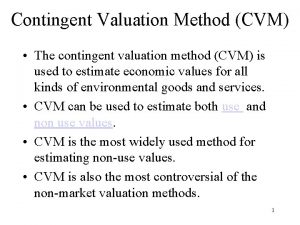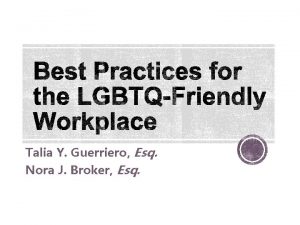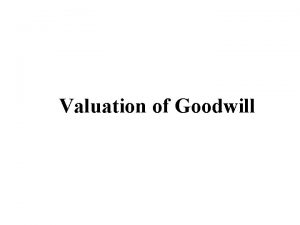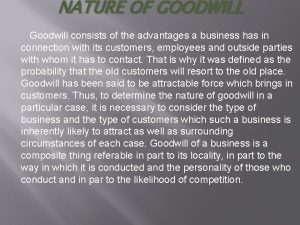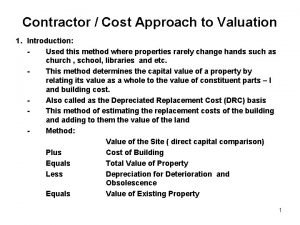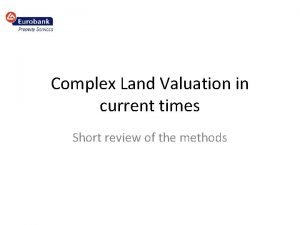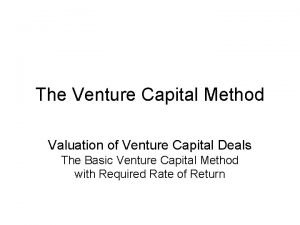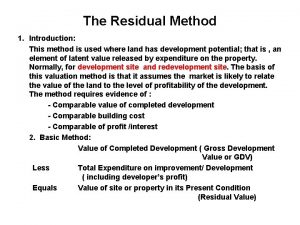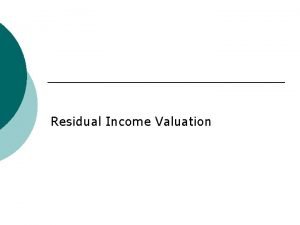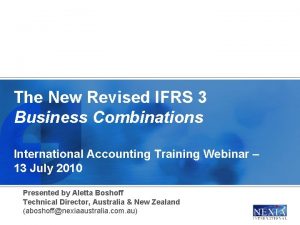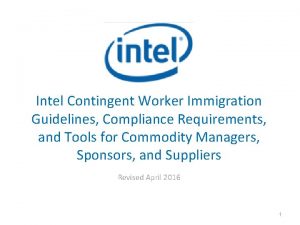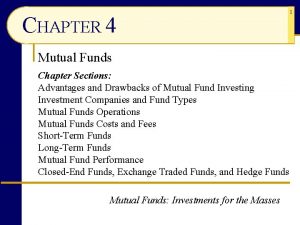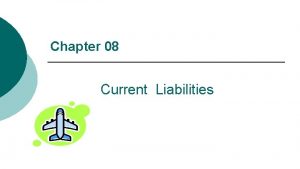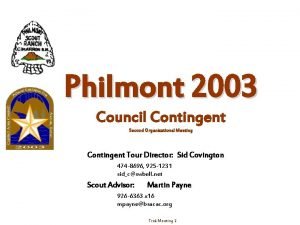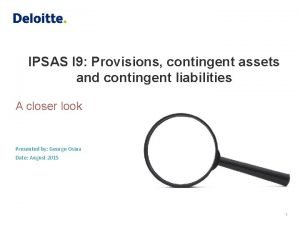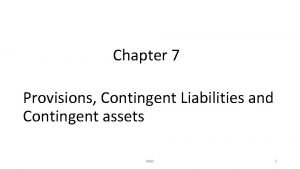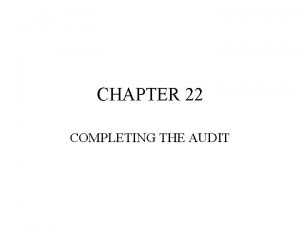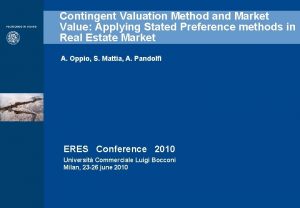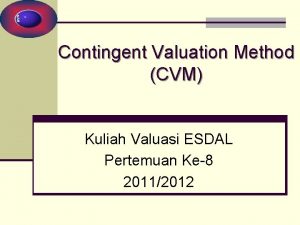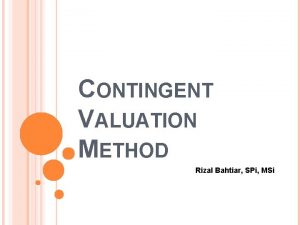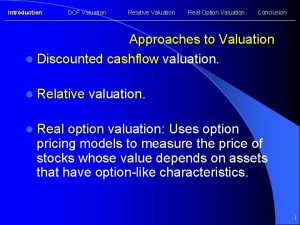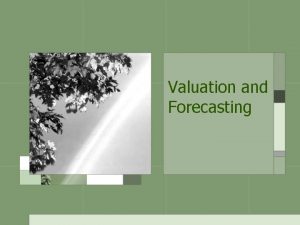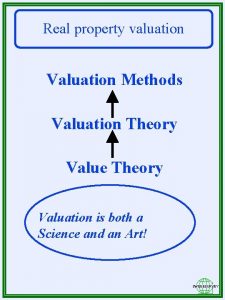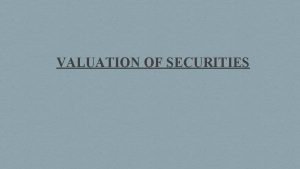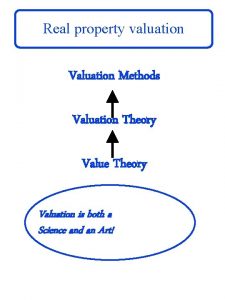Contingent Valuation Method Dr Carla Guerriero Carlagmail com

























- Slides: 25

Contingent Valuation Method Dr. Carla Guerriero. Carla@gmail. com

Why valuation? • Once policies, biodiversity indicators, scenarios, targets have been identified, it is useful to compare them with the status quo by quantifying impacts in monetary terms. • We have the opportunity to advise policy makers! • Enable environmental impacts to be included in Cost. Benefit-Analysis (CBA) and therefore in Integrated Assessment • To take account of environmental damages/benefits caused by the consequences of trade related policies • To consider the monetary benefits of additional policies that protect/enhance the quality of the environment (biodiversity) • The benefits can be of different types: (e. g. health benefits; air quality benefits; increase in real estate 2 prices)

How do we valuate the effects of environmental policies? • Market based approaches – Production function – Cost of illness – Cost based • Non-marked valuation techniques – – – Hedonic pricing method Travel cost method Contingent valuation Choice experiments Benefits transfer 3

Categories of environmental benefits • Total economic value = Use values + Non use values • Non use values= Option values + Existence values + Bequest values • Use Values: benefits that derive from the actual use of the environment (using herbs for medicinal purposes) • Option values: additional value placed on a natural resource by those people who want to have the option of using the goods and services in the future • Existence values: People wish to maintain or improve environmental assets out of sympathy for animals and nature or from moral conviction. • Bequest values: the desire to preserve environmental assets for the enjoyment of other people of both the present generation and the future generations. 4

Non Market Evaluation techniques • Stated Preferences (Non Use Value) – Contingent Valuation – Discrete Choice Experiments (Choice Modelling) • Revealed Preferences (Use Value) – Travel Cost Model – Hedonic Pricing 5

The Contingent Valuation Method • • - Stated preference technique Questionnaire based Direct method Valuation of a hypothetical scenario It is called “contingent valuation” because the valuation is contingent on the hypothetical scenario put to respondents • Willingness To Pay (WTP) question 6

Stated Preference Techniques: CVM An interview is used to create the hypothetical market within these questions are asked. The hypothetical market comprises two key parts: a statement of the proposed change; and an institutional mechanism through which the proposed change is to be provided/avoided and financed. The challenge in conducting a CV is to make the market as realistic as possible. The process of directly questioning a sample group to ascertain their valuation of a change can be divided into six stages. These are (each with a number of steps): definition of survey objectives; design of the questionnaire; surveying the sample population; creating a database and performing an exploratory data analysis; estimating WTP values; and reporting the survey results. 7

CVM: Stage 1 - Project Definition - Theoretical Model CV study should begin with a basic theoretical model: two purposes: Identifies the information required from questionnaire Generates predictions allowing results to be checked Number of sources of information that can be used to construct the model, including: predictions of economic theory and existing literature, discussion/meetings with focus groups/affected parties. Participants discuss understanding of the context of the good/service in question, the good/service itself, its “value”, who should provide it, how it should be paid for, whether they would contribute, etc. The information from the focus groups is particularly valuable in designing the CV survey. 8

CVM: Stage 1 - Project Definition - Sample Design For a site-specific resource, the sample may be drawn from: Visitors to the site (‘on-site’ sample) • does not elicit information on the WTP of ‘non-users’; • interviews must be kept short; • procedure is needed to select among visitors to a site Households within a certain radius of the site (‘off-site’ sample) • geographical boundaries need to be defined; • a larger sample required, many households may not visit the site It is also important to carefully select the size of the sample: A larger means more confidence that the sample mean WTP is a reliable estimate of the ‘true’ mean WTP. (Balance precision and survey cost) 9

CVM: Stage 2 - Questionnaire Design - Background Questions General background: Questions on general characteristics of the respondents – information for checking the validity of the valuation results Respondents’ tastes and socio-economic characteristics (is the sample representative? ). Personal details - should , come at the end of the questionnaire (for example the sample should include all income groups if the mean WTP has to be used for general population. Respondent’s knowledge of the commodity in question, e. g. background questions concerning the respondent’s visits to a recreation site should cover such issues as: • attitudes towards environmental issues; • proximity of their home to the site; • frequency of visits; • duration of trip; • reason for visit, etc. (e. g. Marghera remediation site distance from remediation site; health risk perception ) These questions should be asked at the beginning of the interview as they are relatively straightforward to answer, and will help to build-up the respondent’s confidence. 10

CVM: Stage 2 - Questionnaire Design - Preparation Questions To avoid bias, interviewer must make sure the respondent is aware of: budget constraints (you cannot spend more than you have!) their right to refuse to pay for the good If the event of a negative response, the reason must be recorded a ‘zero valuation’ is implied if: the respondent may not be able to pay anything; or the respondent may not be willing to pay anything. a ‘protest bid’ is implied if: the respondent may find it too difficult to establish a monetary valuation; the respondent may disapprove of the concept of expressing 11 environmental resources in monetary terms; or may be hostile

Different format of WTP question • Open Ended: – “How much are you willing to pay for public good A? ” • Bidding Game: – 1) “Are you willing to pay X for public good A? ” – 2 a) If Yes to (1), “Are you willing to pay Y for public good A? ” (Y>X) – 3 a) If Yes (2 a), “Are you willing to pay Z for public good A? ” (Z>Y). – 4 a) if Yes to (3 a) … – If No to (Na), WTP questions stop. – 2 b) If No to (1), “Are you willing to pay T for public good A? ” (T<X) – … • Payment Cards: – choose a WTP point estimate from a list of values 12

• Dichotomous or Discrete Choice CV (Referendum format): – “Are you willing to pay X for public good A? ” => STOP • Dichotomous or Discrete Choice CV with follow-up: 1) “Are you willing to pay X for public good A? ” 2 a) If Yes to 1, “Are you willing to pay Y for public good A? ” => STOP 2 b) If No to 1, “Are you willing to pay Z for public good A? ” => STOP (Y>X) (Z<X) 13

CVM: Stage 2 - Survey Design - “Open-ended” Elicitation Format Respondent simply asked to state maximum WTP for a specific environmental change The advantages of the open ended: Quick and easy to administer and analyse; Can be performed with a smaller sample size; Avoids ‘anchoring’ effects - respondents influenced by suggested starting value. Main drawbacks: Makes strategic bias, more likely The respondent may need a reference point to bound value judgement 14 Respondent must be familiar with the affected commodity in

CVM: Stage 2 - Questionnaire Design - “Dichotomous Choice” or “Referendum” Elicitation Format range of values for the max WTP of individuals pre-set. sample of respondents is divided into sub-samples. value within the pre-set range is assigned to each sub-sample (the source of he so-called ‘anchoring effect’). Each respondent asked whether WTP assigned value for proposed change Answer not the max WTP – only consent or refusal to pay a given amount Random utility theory (logit model) are required to estimate the respondent’s mean and median WTP values. Requires large sample. No Incentive to engage in strategic behaviour. Easier to convey decision rule - >50% say “yes” change provided. Realistic – individuals typically make decisions faced with fixed 15 prices.

NOAA Panel Guidelines • Conservative design => better to underestimate WTP • WTP, rather than Willingness to Accept (WTA) • Referendum format (i. e. Yes/No Questions) • Accurate description of the good/scenario => use of focus groups and pretest of the survey instrument • Reminder of substitute commodities • Yes/No follow ups • Checks on understanding and acceptance • Cross tabulations • Sample size circa 500 is a minimum. 16

Other important aspects for questionnaire development (1) • Mail / In Person / On the Phone interview • In person => costly, interviewer bias, time consuming, more accurate, better option if it is difficult to explain the scenario (need pictures), only users if on site • Mail => low response rate, sampling bias => who takes the survey? Those who are interested in the topic? , limited information, relatively inexpensive • Telephone => relatively inexpensive, limited information, not accurate, response rate, developing countries? • Mail + Telephone • Internet • Computer based instruments 17

Other important aspects for questionnaire development (2) 1. Introduction 2. Warm-up questions 3. Questions on the knowledge of the problem / experience with the environmental good => USE values, etc 4. Description of the scenario 5. WTP question(s) 6. Debriefing questions => why did you vote in favour or against the program 7. - Use and Non-Use values investigation => did you vote yes, because (a) you will visit the national park, (b) even if you will never visit the national park, you want future generations to visit the park, etc. 8. Attitudinal questions 9. Socio – demographic questions. Ask questions on Income at the end of the questionnaire!!! => we don’t want to irritate the respondent 18

Other important aspects for questionnaire development (3) • Identify protest respondents after the WTP questions (ask why the respondent voted YY, NN, NY, YN) • Analyze the data for the full sample of respondents, then delete those respondents that show protest behaviours • Income. Try to get an answer to the income question. In developing countries, sometimes researchers (Cropper, Alberini) ask a list of expenditures. If you have no information on income from some respondents, don’t loose those observations. Add a dummy equal to 1 for those that did not answer the income question, and 0 otherwise. Set equal to 0 the income of those respondents that did not answer the income question. In your regression the coefficient of the dummy for those that did not answer the income question tells if they are statistically different from those that reported income. In this way you don’t loose the observations! • Clearly define the population of interest • Consider your budget constraint • Make sure that your referendum question avoids free rider 19 behaviours!

Payment vehicle • Whose welfare we interested in? => Important for sampling plan • TAX => One time Tax is incentive compatible • How do we choose the tax level? Focus groups, previous research, pretest, optimal bidding design literature, cost of the public program 20

CVM: Stage 2 - Questionnaire Design - Payment Vehicle Valuation question needs a realistic institutional context - usually an appropriate payment (or bid) vehicle (instrument). The payment vehicle is the mechanism through which the WTP/WTA values are to be raised/distributed. Key considerations when selecting a payment vehicle are: familiarity – does the respondent understand the payment vehicle? credibility – does the payment vehicle represent a realistic situation? empathy – is the respondent favourably or unfavourably disposed towards the recipient of the funds? feasibility – is the recipient of the funds capable of delivering the improvement? universality – would all the respondents be affected by the payment vehicle? 21

WTP and WTA • The goal of contingent valuation is to measure the compensating or equivalent variation for the good in question. Both compensating and equivalent variation can be elicited by asking a person to report a willingness to pay amount. For instance, the person may be asked to report his WTP to obtain the good, or to avoid the loss of the good. Formally, WTP is defined as the amount that must be taken away from the person’s income while keeping his utility constant: 1) where V denotes the indirect utility function, y is income, p is a vector of prices faced by the individual, and q 0 and q 1 are the alternative levels of the good or quality indexes (with q 1>q 0, indicating that q 1 refers to improved environmental quality). Z is a vector of individual characteristics. • (Compensating variation is the appropriate measure when the person must purchase the good, such as an improvement in environmental quality. Equivalent variation is appropriate if the person faces a potential loss of the good, as he would if a proposed policy results in the deterioration of environmental quality. ) 22

• Willingness to accept (WTA) is defined as the amount of money that must be given to an individual experiencing a deterioration in environmental quality to keep his utility constant: 2) • Where q 2 indicates a deterioration in quality compared to the status quo, q 0. • In equations (1) and (2), utility is allowed to depend on a vector of individual characteristics influencing the tradeoff that the individual is prepared to make between income and environmental quality. An important consequence of equations (1) and (2) is that WTP or WTA should, therefore, depend on (i) the initial and final level of the good in question; (ii) respondent income; (iii) all prices faced by the respondent, including those of substitute goods or activities; and (iv) other respondent characteristics. • Internal validity of the WTP responses can be checked by regressing WTP on variables (i)-(iv), and showing that WTP correlates in predictable ways with socio-economic variables. 23

• median WTP is generally regarded as a robust, and conservative, welfare statistic associated with the good or proposed policy. It is usually estimated more precisely than mean WTP, and is interpreted as the value at which 50% of the respondents would vote in support of the program, and hence the cost at which the majority of the population would be in support of it. 24

Literature for this lecture 25
 Contingent valuation method
Contingent valuation method Contingent valuation method
Contingent valuation method Define contingent valuation
Define contingent valuation Bài thơ mẹ đi làm từ sáng sớm
Bài thơ mẹ đi làm từ sáng sớm Cơm
Cơm Talia guerriero
Talia guerriero Assiri e babilonesi
Assiri e babilonesi Nicole guerriero agent
Nicole guerriero agent Fixed income valuation methods
Fixed income valuation methods Capital employed formula from liabilities side
Capital employed formula from liabilities side Arbitrary method of goodwill
Arbitrary method of goodwill Contractors method of valuation
Contractors method of valuation Avco stock valuation
Avco stock valuation Contractors method of valuation
Contractors method of valuation Residual method of valuation pros and cons
Residual method of valuation pros and cons Venture capital method
Venture capital method Residual method of valuation
Residual method of valuation Need for valuation of goodwill
Need for valuation of goodwill Rim valuation
Rim valuation Dvm valuation method
Dvm valuation method Share valuation
Share valuation Contingent liability journal entry
Contingent liability journal entry Contingent worker letter
Contingent worker letter Contingent deferred sales charge
Contingent deferred sales charge How to record contingent liability
How to record contingent liability Loss contingency journal entry
Loss contingency journal entry


